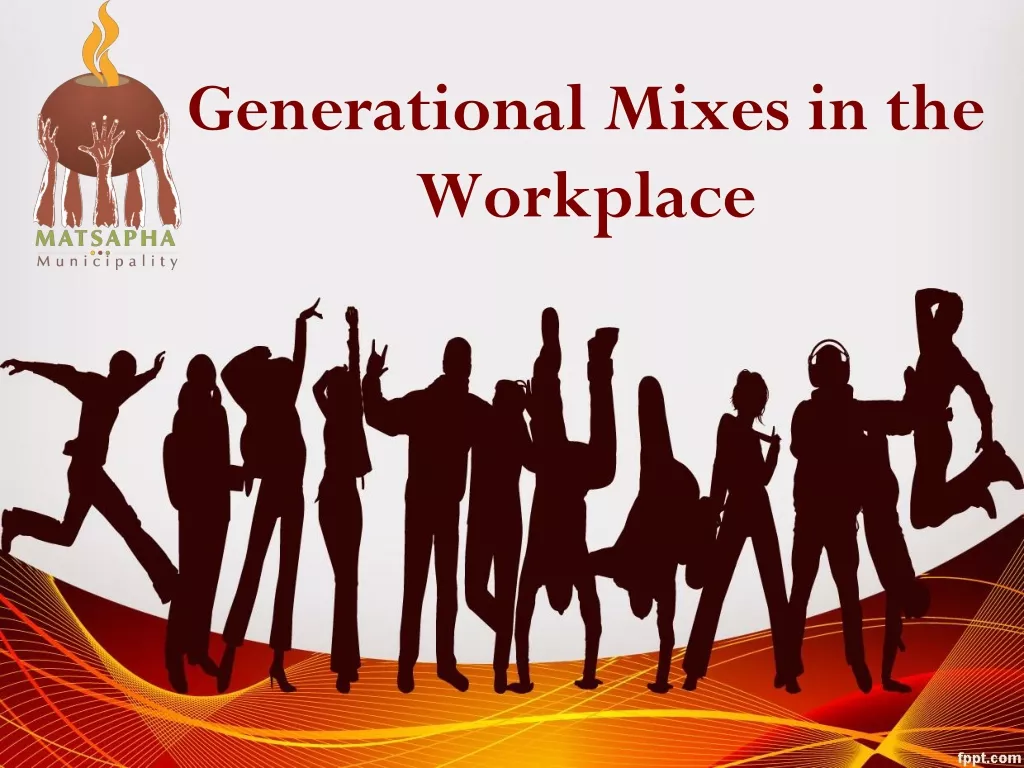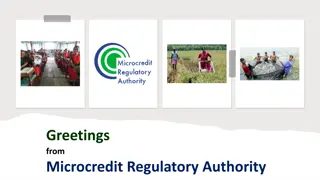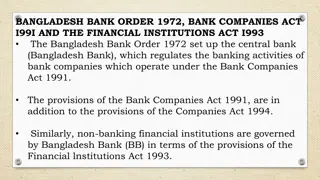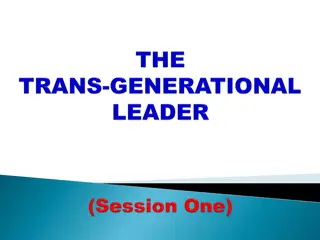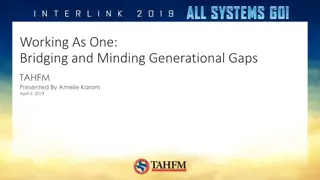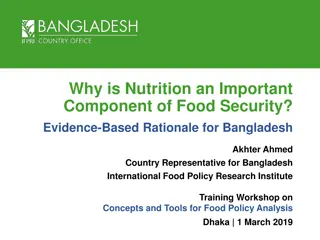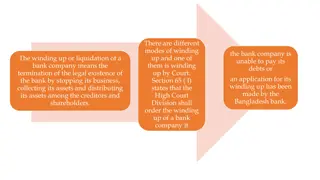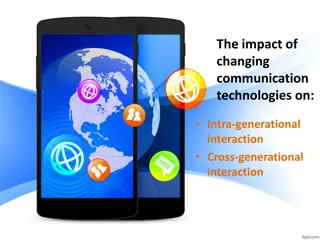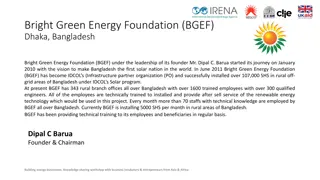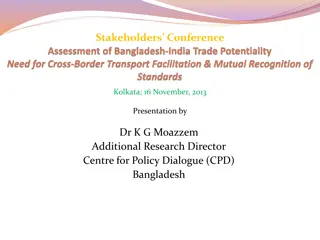COVID 19 Impacts on Generational Economy in Bangladesh
This presentation delves into the severe consequences of COVID-19 on social and economic indicators in Bangladesh, proposing a combined approach to assess the impacts and stimuli from macro, sectoral, and generational perspectives. It explores the methodology, data, pre-COVID-19 situation, rising inequality concerns, and simulation results using a CGE model.
Download Presentation

Please find below an Image/Link to download the presentation.
The content on the website is provided AS IS for your information and personal use only. It may not be sold, licensed, or shared on other websites without obtaining consent from the author.If you encounter any issues during the download, it is possible that the publisher has removed the file from their server.
You are allowed to download the files provided on this website for personal or commercial use, subject to the condition that they are used lawfully. All files are the property of their respective owners.
The content on the website is provided AS IS for your information and personal use only. It may not be sold, licensed, or shared on other websites without obtaining consent from the author.
E N D
Presentation Transcript
COVID 19 Impacts on Generational Economy in Bangladesh An Application of National Transfer Account Bazlul Khondker and Moshiur Rahman 13th Global Meeting on Population and the Generational Economy August 7, 2020
Presentation Outline Four Parts Part A: Context, Methodology and Data Part B: Pre-COVID 19 Situation and Social Protection System Part C: COVID Generational Economy Part D: Conclusion 19 Impacts on
Context COVID 19 exerted severe negative consequences on social and economic indicators. Multilateral agencies/Countries economywide modeling approaches (such as SAM/CGE) to assess COVID 19 cost. No attempt to assess the COVID 19 impacts and stimulus from the perspectives of generational economy or NTA. We propose to combine the economywide modeling approach with NTA approach for deeper understanding of the COVID 19 impacts. Combination of them would help us to assess the impacts (of COVID 19) as well as the stimulus from macro, sectoral and generational perspectives. have adopted the
Before COVID 19 Rosy Picture! 341.4 140.7 64.0 32.0 18.9 8.2 3.7 Nominal GDP (Bil $) Real GDP (Bil $) GDP growth rate Employed person (Mil) Unemployment rate (%) Poor person (Mil) Poverty rate (%) (%) GDP/Income Employment Poverty According to officials data and key indicators Bangladesh s performances were good 8.2% growth | 3.7% unemployment rate | Further improvements in poverty rate to 18.9% and extreme poverty rate to 9.4%.
Concerns Rising Inequality and LCD Child and Elderly LCD Consumption Gini Coefficient 5000 40.0 35.0 33.4 33.2 32.9 36.9 32.132.4 35.0 33.0 4000 31.6 4,294 30.0 Billion BDT 25.0 31.0 3000 21.5 28.8 20.0 % 2,841 29.0 2000 15.0 27.6 1,764 10.0 Growth hurting inequality 0.27 + 695 27.0 1000 398 26.9 209 5.0 25.0 25.9 0 0.0 10.4 2016 10.9 2020 7.2 2010 23.0 1980 1983 1986 1989 1992 1995 1998 2001 2004 2007 2010 2013 2016 Elderly LCD (Bill BDT) Child LCD (Bill BDT) Public share (CLCD)% Public share (ELCD) % Income Gini also rising and 0.16 percentage points higher (0.486 in 2016) In every society Children (0-17) and elderly (65+) don t earn (Y) but consume (C), the gap (C-Y) is called life cycle deficit (LCD). They are increasing fast and coverage is mainly from private transfers.
CGE: Simulation Design | Results | Linkage Simulation Design Bangladesh CGE Model rE Investments Underutilization of capital A simulation carried out with CGE model 2020 15 % reduction in RMG exports | 3.7 % fall in remittances | 8 weeks lockdown BANGLADESH CGE MODEL COVID 19 shock (demand fall) Rest of the World Reduction in RMG demand Decline in Remittance Exports Imports Investment Product markets GDP growth rate drop to 1.5% and Household reduced by 13%. Produce goods and services S=I income Balance Demand Goods and services Government consumption Intermediates Economic Sectors: AGR (6) IND (9) CONS (1) SRV (7) CGE results linked to the Bangladesh NTA 2020 to assess impacts on the generational economy income, consumption and LCD Taxes Taxes Households (7 types) Government Firms Savings Transfers, Services Services Supply inputs (K, L 2 types) Demand inputs (K, L 2 types) SP STIMULUS COVID 19 shock (lockdown) Factor markets
Results: Generational Economy Children | Elderly LCD (Post COVID 19) Per Capita Income (Y) |Consumption (C) 160000 Children LCD Elderly LCD 140000 120.0 120.0 % of Pre-Covid Consumption 120000 % of Pre-Covid Consumption 100.0 100.0 100000 Per Capita (BDT) 80.0 80.0 80000 60.0 60000 60.0 40.0 40000 40.0 20.0 20000 20.0 0 0.0 0.0 0-4 5-9 10-14 15-19 20-24 25-29 30-34 35-39 40-44 45-49 50-54 55-59 60-64 65-69 70-74 75-79 80-84 85-89 90-94 95-99 75-79 65-69 70-74 80-84 85-89 90-94 95-99 0-4 5-9 10-1415-19 Post-COVID 19 Post-COVID 19 Pre_Covid 19 Y Post_Covid 19 Y Pre_Covid 19 C Post_Covid 19 C Pre-COVID 19 Pre-COVID 19 LCD (% of pre-covid 19 consumption) LCD and Transfers Child LCD Increased Elderly LCD Widened 100.0 80.0 4,900 11.0 800.0 38.0 60.0 10.9 10.8 4,800 37.0 36.9 780.0 40.0 4,818 10.6 779.48 4,700 36.0 760.0 20.0 10.4 4,600 35.0 0.0 740.0 Billion BDT Billion BDT 10.2 4,500 34.0 -20.0 10.0 % 720.0 % 4,400 33.0 -40.0 32.9 9.8 700.0 9.7 4,300 -60.0 32.0 9.6 694.7 4,294 680.0 -80.0 4,200 31.0 9.4 -100.0 660.0 4,100 30.0 9.2 0-4 5-9 10-14 15-19 20-24 25-29 30-34 35-39 40-44 45-49 50-54 55-59 60-64 65-69 70-74 75-79 80-84 85-89 90-94 95-99 4,000 9.0 640.0 29.0 Pre-COVID 19 Post-COVID 19 Pre-COVID 19 Post-COVID 19 Pre-COVID 19 Post-COVID 19 LCD (Billion BDT) Pubic transfer share (%) LCD (Billion BDT) Pubic transfer share (%)
Discussion Assuming that intra-household resource transfers still follows the pre-COVID 19 patterns it is found that the LCDs of the deficit generations children and elderly deteriorated under the post-COVID 19 due to contraction of the economy and reductions of the factor income. The deteriorations are larger for the early childhood (aged 0 to 9) and persons with age 85 and over generations. If their consumptions are not supported child and old age mortality may spike successes on the nutritional front may be lost, and productivity of future generations may be compromised These call for increase in public transfers
Global Approach to SP Responses Use existing SP by Vertical expansion: increase the transfers value Horizontal expansion: expand the number of recipients Introduce new scheme IMF universal transfers in South Asia WB need to consider universal social protection entitlements that reach the missing middle UN universal transfer from human rights and SG perspectives Most countries increased cash transfers using digital infrastructure registration and payment As a rough rule of thumb . a near-term fiscal injection of transfers less than 2% of GDP should be judged as inadequate (Martin Ravallion, 2020) Survey of 173 countries social assistance dominates Non-contributory 60% of global response Elements of Vertical/Horizontal Response programme Increase in both adequacy & coverage [10 countries|13 measures] Verticalexpansion Only adequacy increase [45 countries|63 measures] Only coverage increase [157 countries|385 measures] Admin adaption [41 countries|62 measures] for Horizontal expansion Source: Gentilini et al. (2020)
Conclusion An attempt has been made to integrate generational economy with the widely used economywide approach to look beyond impacts on macro and sectoral indicators. The results highlight the financing of the generational deficits which is mainly private due to low public expenditures in education, health, nutrition and social protection. It also re-emphasised the importance of high, sustained and inclusive economic growth to support the generational equity and livelihood in the context of Bangladesh. The analysis captures the precarious impacts on the consumption of the deficit generations children and elderly. Private transfers which constitute the main sources of the consumption of the children are under threat and thus call for an effective public transfer in the form of child benefit, social pension or family benefit as long as the economic situation returns to normalcy.


